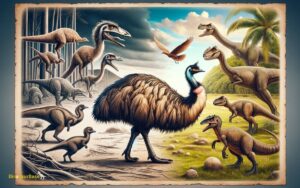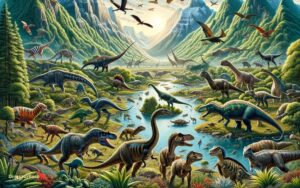What Are Dinosaur Shrimp
Isn't it fascinating how some creatures serve as living fossils, granting us a window into Earth's distant past? Dinosaur shrimp, with their ancient lineage, have remained virtually unchanged for millions of years, offering scientists and enthusiasts alike a glimpse into prehistoric life. These intriguing organisms, often overlooked, have survived epochs, adapting to various environmental shifts while maintaining their primordial forms.
Exploring their world not only enriches our understanding of evolution but also raises intriguing questions about resilience and adaptation in nature. One might wonder, how have these creatures withstood the test of time, and what secrets do they hold about survival in Earth's ever-changing landscape?
Key Takeaways
- Dinosaur shrimp are ancient crustaceans known scientifically as Notostraca, surviving since the Paleozoic era.
- They are considered living fossils, exhibiting remarkable evolutionary stasis while adapting to changing environments.
- Their diet is omnivorous, contributing to their adaptability and resilience in various habitats.
- Research and conservation efforts focus on understanding their genetic makeup and restoring their natural habitats.
Unveiling Dinosaur Shrimp
Dinosaur shrimp, an ancient group of crustaceans, have persisted through millions of years, embodying a fascinating example of evolutionary resilience. These creatures, often referred to as living fossils, exhibit remarkable adaptability to their environments. Their existence challenges our understanding of species survival, suggesting that some organisms can withstand catastrophic events that lead to mass extinctions.
Dinosaur shrimp's unique physical characteristics, such as their hard exoskeleton and the ability to enter a state of cryptobiosis, contribute significantly to their longevity. This state allows them to survive extreme conditions by halting their metabolic processes. Researchers study these crustaceans not only to unravel the secrets of their survival but also to gain insights into the broader principles of evolutionary biology. Their continued presence is a testament to the complexity and unpredictability of life on Earth.
Ancient Origins Explored
Exploring the ancient origins of dinosaur shrimp reveals their prehistoric existence, tracing back millions of years.
This analysis uncovers their evolutionary journey, highlighting significant adaptations that have enabled their survival through drastic environmental shifts.
Scholars argue that these creatures serve as a living testament to the resilience and complexity of life on Earth.
Prehistoric Existence Unveiled
Delving into the depths of Earth's ancient past reveals the existence of 'dinosaur shrimp,' a term that encapsulates the enduring legacy of these prehistoric creatures within the aquatic ecosystems they once dominated. These enigmatic entities, scientifically known as Notostraca, have traversed the eons, their evolutionary lineage stretching back to the Paleozoic era. Their survival speaks volumes about their adaptability and resilience in the face of changing environmental conditions and predatory pressures.
Analysis of fossil records indicates that these crustaceans have maintained a remarkable consistency in form and function, suggesting a successful evolutionary strategy. Their presence in ancient sediment layers provides invaluable insights into the biodiversity and ecological dynamics of prehistoric aquatic habitats, underscoring their significance in the broader tapestry of life's history on Earth.
Evolutionary Journey Highlighted
Building upon the understanding of Notostraca's enduring legacy, we now turn our attention to the evolutionary journey that underscores their ancient origins and remarkable persistence through geological epochs.
The Notostraca lineage, colloquially known as 'dinosaur shrimp,' showcases a remarkable evolutionary history, tracing back over 300 million years. This span encompasses significant planetary transformations, including mass extinctions and climatic shifts, which they've navigated with astounding resilience.
Their morphological consistency over time suggests a successful adaptive strategy that minimized the need for drastic evolutionary changes. This constancy, a phenomenon known as stasis, highlights their evolutionary strategy of maintaining a stable form while adapting to environmental changes at a genetic or behavioral level.
Their survival is a testament to the robustness of their ecological niche and evolutionary adaptability.
Unchanged Through Millennia
Despite millions of years of evolutionary pressure, dinosaur shrimp have remained remarkably unchanged, showcasing an extraordinary example of evolutionary stasis. This phenomenon, known as living fossils, presents a unique opportunity for scientists to study the ancient past within the present.
The morphological and physiological traits of these crustaceans have shown minimal alterations through eons, suggesting their existing design was highly optimized for survival in their ecological niche. This lack of change challenges the common perception that constant adaptation is necessary for survival. Instead, dinosaur shrimp underline the concept that under certain stable environmental conditions, evolutionary changes may be minimal.
Their persistence through mass extinctions and geological upheavals further underscores their resilience and the efficiency of their ancient design in navigating the complexities of evolutionary pressures.
Habitat and Lifestyle
Dinosaur shrimp inhabit ancient aquatic environments that have remained relatively unchanged over millions of years, providing a unique window into prehistoric life.
Their daily feeding habits, characterized by a diet that consists primarily of microorganisms and organic detritus, reflect their adaptation to these specific ecological niches.
Such behaviors underscore the shrimp's resilience and the crucial role their habitats play in their survival and evolutionary stasis.
Ancient Aquatic Environments
Exploring ancient aquatic environments reveals a diverse ecosystem in which species such as the dinosaur shrimp thrived, adapting to various habitats and lifestyles over millions of years. These prehistoric waters presented a range of conditions, from shallow, warm pools to deeper, colder segments of ancient seas. The adaptability and resilience of these creatures highlight their evolutionary success.
Key elements of their ancient habitats included:
- Variable Salinity: Ranging from brackish waters to fully marine conditions, allowing for a wide adaptability.
- Diverse Temperature Ranges: From warm tropical waters to cooler temperate zones, reflecting their broad ecological tolerance.
- Varied Depths: Occupying both shallow and deeper waters, indicating a flexible lifestyle.
- Rich Biodiversity: Co-existing with a multitude of other species, suggesting a complex ecosystem with intricate food webs, excluding their specific feeding habits.
Daily Feeding Habits
Building on the understanding of ancient aquatic environments, it's crucial to examine how the dinosaur shrimp's daily feeding habits reflect their adaptability and ecological role within these diverse habitats.
Dinosaur shrimp engage in a behavior known as filter feeding. This involves swimming or being stationary in water, where they use their finely feathered appendages to sift detritus and microorganisms from the water column.
This method isn't only efficient but also underlines their role as key participants in the aquatic food web, contributing to the recycling of organic matter. Their feeding behavior showcases an evolutionary adaptation that has enabled their survival across eons.
Survival and Adaptation
Adapting over millions of years, dinosaur shrimp have developed unique survival mechanisms to thrive in environments subject to extreme changes. These ancient crustaceans exhibit remarkable resilience, underscoring their evolutionary success.
Their adaptation strategies include:
- Cryptobiosis: A state of suspended animation that enables survival during droughts.
- Rapid Reproduction: Capable of quickly repopulating when conditions become favorable.
- Environmental Sensitivity: Exceptionally responsive to environmental cues for hatching and growth.
- Dietary Versatility: An omnivorous diet that allows utilization of various food sources.
These mechanisms not only illustrate the dinosaur shrimp's ability to endure through epochs but also its evolutionary intelligence in navigating the challenges of drastically fluctuating habitats. Their survival strategies offer profound insights into adaptability and resilience in the natural world.
Studying and Preserving
Given the dinosaur shrimp's unique survival mechanisms, researchers now focus on the imperative of studying and preserving these ancient crustaceans to understand their resilience and evolutionary success further. This scholarly pursuit involves analyzing their genetic makeup, which offers insights into their adaptability to changing environments over millions of years.
Experts employ modern biotechnological tools to decode the secrets locked within their DNA, aiming to uncover why dinosaur shrimp have outlasted numerous mass extinctions. Preservation efforts are equally crucial, emphasizing the restoration of their natural habitats, which have been increasingly threatened by human activity and climate change.
These efforts not only safeguard the species but also contribute to the broader understanding of ecological balance and the importance of biodiversity in maintaining healthy ecosystems.
Conclusion
In the grand tapestry of life, dinosaur shrimp serve as living fossils, embodying the persistence of nature amidst relentless change. These ancient mariners, navigating through millennia in the silent depths, remind us of life's tenacity and evolution's intricacy.
Their unchanged form, a testament to adaptation's nuanced art, highlights the importance of biodiversity and the need for meticulous conservation. In studying these prehistoric survivors, humanity gains profound insights into resilience, underscoring the imperative to safeguard the delicate balance of our planet's ecosystems.



